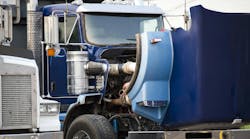Manager: Ted Hendrix
Title: Assistant Chief
Fleet: Ranlo Fire and Rescue, Ranlo, NC
Operation: Volunteer fire department
PROBLEM
Fighting fires and racing the injured to hospitals are the toughest and most dangerous aspects of volunteering firefighting, but the job doesn't end there. Although relatively mundane, other things must be taken care of, including managing the cost of fuel. Ted Hendrix struggled with that particular chore for more than a few years as the assistant chief of the volunteer fire and rescue company serving Ranlo, NC. He found it difficult to keep tabs on exactly where all the gasoline and diesel used by the fire and rescue squad's eight-vehicle fleet went.
“The bill our local fuel provider sent each month only told us how much gasoline and diesel we used,” he explains. “The bill didn't tell me anything about our fuel use patterns. We didn't know how much each truck used, when the fuel got pumped, etc.”
In addition, since there was only one pump activation code, Hendrix had no idea who pumped fuel at any given time.
And since the volunteer force was spread out over several shifts, Hendrix could go weeks or months without seeing some of the firefighters. “Asking who filled up what truck on a specific day was almost useless; you could never determine anything with accuracy,” he says.
In addition, the fuel provider's billing cycle was out of sync with Ranlo's payment schedule. “We were always behind, but they wouldn't change their cycle to match ours. So not only did I need an uncomplicated way to get more data about out fueling patterns, I needed to get our fuel bills matched up with our payment cycle.”
SOLUTION
Following the lead of the county fleet headquartered in nearby Gastonia, NC, Hendrix put the Fuelman fleet card system into operation to getter a better grasp of where all of his fuel was going.
Each firefighter and each vehicle gets a unique PIN (personal identification number), which is also associated with the tank capacity. “If a truck with a 20-gallon tank pulls up to the fuel station and suddenly pumps 30 gallons, within an hour I get an email about it,” he says.
The identifiers also help Hendrix track how much fuel each vehicle is using. He has the option of setting a limit on the amount of fuel that can be dispensed at one time, although he typically doesn't use that function, since most of the equipment onboard the trucks — chainsaws, power saws, etc. — needs to be refueled as well.
“All this information is available both online and on my monthly bill, so I can go to our Board of Directors at any time and show them our fuel purchases in detail: by personnel, vehicle, time of refueling, etc.,” he explains.
Mitchell Tourat, senior vp-sales for FleetCor, which provides the Fuelman card program, says that flexibility is another key attribute. Fleets can set purchase limits by time of day, day of week, transactions per day, dollars per day or gallons per day. “You can change fueling limits on vehicles and specific cards as you go along, depending on your needs. You make adjustments based on the use patterns you see at the moment, not ones that are days or weeks old.”
Maintenance Bay presents case studies detailing how fleets resolve maintenance-related issues.


